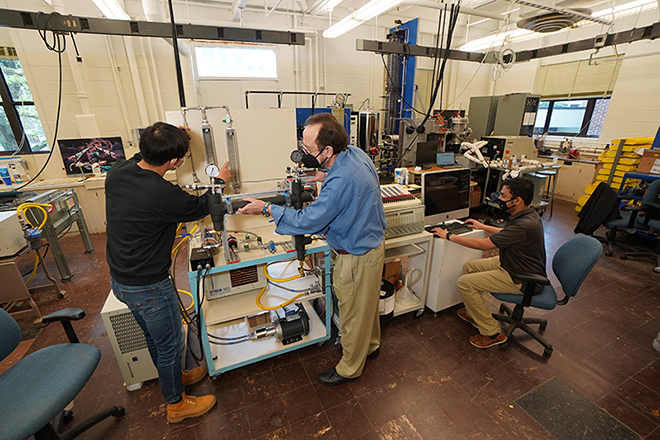The road to faster charging runs through greater cooling capacity (so to speak). Higher charging power levels mean higher current, which means that greater amounts of heat must be removed from charging cables.
Purdue University engineers have invented a new, patent-pending charging cable that uses a novel cooling method. The researchers say their wonder cable can remove up to 24.22 kilowatts of heat, and thus can deliver a current 4.6 times that of the fastest currently available chargers.
The project was funded by an R&D alliance between Purdue and Ford.
“My lab specializes in coming up with solutions for situations where the amounts of heat that are produced are way beyond the capabilities of today’s technologies to remove,” said Purdue Professor Issam Mudawar.
Though the prototype hasn’t been tested on EVs yet, Mudawar and his students demonstrated in the lab that their prototype accommodates a current of over 2,400 amps, more than enough to reduce charging times for large commercial EVs to five minutes. The most advanced chargers “currently” available deliver only 520 amps.
Ultimately, charge times will depend on the power output ratings of the power supply and charging cable, and the power input rating of the EV’s battery. To obtain a sub-five-minute charge, all three components will need to be rated to 2,500 amps.
Mudawar’s lab intends to work with EV or charging cable manufacturers to test the prototype on EVs within the next two years.
EV charging stations rely on liquid cooling systems, but a conventional liquid cooling system for cables would make them heavier and more difficult for drivers to handle.
For the past 37 years, Mudawar has been developing ways to more efficiently cool electronics by taking advantage of the way liquid captures heat when boiled into a vapor. A liquid-to-vapor cooling system can remove 10 times more heat than pure liquid cooling, making it possible to use a smaller wire diameter inside the charging cable while dissipating a higher current.
Research papers on the team’s experimental demonstration of the charging cable prototype and the cooling method it uses have been published in the International Journal of Heat and Mass Transfer.
Mudawar says liquid-to-vapor cooling is so effective at removing large amounts of heat that EVs could charge in far less than five minutes using this technology. “The industry doesn’t really need EVs to charge faster than five minutes, but we think we can increase the current even more by modifying both the state of the incoming liquid and the design of the cooling space around the conductor wires in the charging cable. My lab has developed solutions using liquid phase change technology for many applications, including in aerospace and defense. We knew how capable the technology is.”
Source: Purdue University

lasuna online buy – order diarex himcolin order online
besivance tubes – carbocisteine pills sildamax where to buy
order neurontin sale – order sulfasalazine online azulfidine without prescription
benemid 500 mg generic – buy monograph for sale order carbamazepine 400mg pill
buy colospa 135mg for sale – pletal where to buy pletal 100mg canada
celecoxib usa – indomethacin 50mg without prescription purchase indomethacin pills
buy rumalaya online cheap – rumalaya pills endep 50mg uk
order diclofenac – buy imdur pills buy generic nimotop
order lioresal without prescription – order lioresal pill feldene for sale
order mobic 7.5mg – meloxicam without prescription toradol usa
cyproheptadine canada – buy zanaflex generic zanaflex without prescription
order trihexyphenidyl generic – where can i buy voltaren gel order cheap emulgel
buy isotretinoin 10mg sale – aczone 100mg price deltasone 10mg for sale
purchase cefdinir generic – how to buy clindamycin cleocin price
order deltasone 5mg generic – purchase omnacortil order permethrin creams
buy permethrin cream – benzac without prescription buy generic retin cream
how to get metronidazole without a prescription – flagyl 400mg brand buy cenforce 100mg without prescription
cheap betnovate 20gm – differin price generic benoquin
augmentin 625mg for sale – order augmentin 1000mg sale order synthroid generic
cozaar 25mg oral – buy cephalexin pills for sale order keflex 250mg online cheap
cost eurax – order generic crotamiton order generic aczone
order zyban 150 mg for sale – cheap ayurslim sale shuddha guggulu online
provigil 200mg usa – buy provigil pills for sale purchase melatonin pills
buy progesterone medication – prometrium 200mg without prescription cheap generic fertomid
capecitabine 500 mg for sale – buy mefenamic acid medication buy generic danocrine 100 mg
order alendronate online – buy alendronate medication order medroxyprogesterone 5mg online cheap
order estradiol 1mg – buy ginette 35 no prescription order arimidex generic
г‚·гѓ«гѓ‡гѓЉгѓ•г‚Јгѓ«гЃЇи–¬е±ЂгЃ§иІ·гЃ€г‚‹пјџ – г‚·г‚ўгѓЄг‚№гЃ®иіје…Ґ г‚·г‚ўгѓЄг‚№ гЃ©гЃ“гЃ§иІ·гЃ€г‚‹
プレドニン処方 – г‚ўг‚ёг‚№гѓгѓћг‚¤г‚·гѓійЂљиІ© г‚ўг‚ёг‚№гѓгѓћг‚¤г‚·гѓі еЂ‹дєєијёе…Ґ гЃЉгЃ™гЃ™г‚Ѓ
гѓ—гѓ¬гѓ‰гѓ‹гѓігЃЇи–¬е±ЂгЃ§иІ·гЃ€г‚‹пјџ – гѓ—гѓ¬гѓ‰гѓ‹гѓійЊ 10 mg еј·гЃ• г‚¤г‚Ѕгѓ€гѓ¬гѓЃгѓЋг‚¤гѓійЊ 40 mg еј·гЃ•
indinavir canada – order indinavir for sale emulgel where to buy
valif hey – sustiva generic purchase sinemet generic
buy modafinil 100mg for sale – cefadroxil 500mg generic combivir where to buy
ivermectin tablets – brand candesartan buy carbamazepine no prescription
phenergan pill – cheap promethazine 25mg buy lincocin 500mg for sale
deltasone pills – capoten price captopril price
buy isotretinoin 20mg generic – isotretinoin without prescription buy zyvox sale
buy generic amoxil – order combivent 100 mcg without prescription order generic ipratropium 100 mcg
cost azithromycin 500mg – tinidazole medication bystolic order
order generic prednisolone 20mg – azipro 500mg generic buy progesterone online